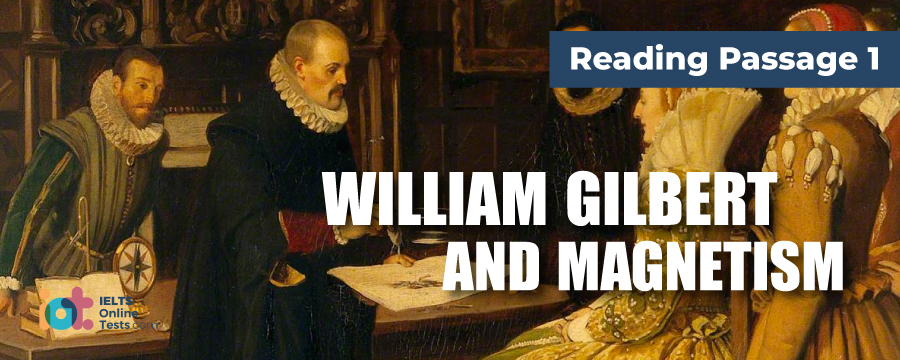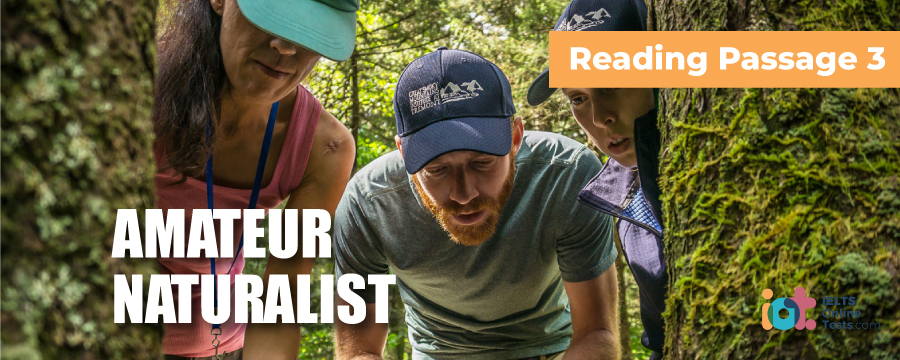Part 1
READING PASSAGE 1
You should spend about 20 minutes on Questions 1-13, which are based on Reading Passage 1 below.

William Gilbert and Magnetism
A
The 16th and 17th centuries saw two great pioneers of modern science: Galileo and Gilbert. The impact of their findings is eminent. Gilbert was the first modern scientist, also the accredited father of the science of electricity and magnetism, an Englishman of learning and a physician at the court of Elizabeth. Prior to him, all that was known of electricity and magnetism was what the ancients knew, nothing more than that the lodestone possessed magnetic properties and that amber and jet, when rubbed, would attract bits of paper or other substances of small specific gravity. However, he is less well known than he deserves.
B
Gilbert’s birth pre-dated Galileo. Born in an eminent local family in Colchester County in the UK, on May 24, 1544, he went to grammar school, and then studied medicine at St John’s College, Cambridge, graduating in 1573. Later he travelled in the continent and eventually settled down in London.
C
He was a very successful and eminent doctor. All this culminated in his election to the president of the Royal Science Society. He was also appointed personal physician to the Queen (Elizabeth I), and later knighted by the Queen. He faithfully served her until her death. However, he didn’t outlive the Queen for long and died on November 30, 1603, only a few months after his appointment as personal physician to King James.
D
Gilbert was first interested in chemistry but later changed his focus due to the large portion of mysticism of alchemy involved (such as the transmutation of metal). He gradually developed his interest in physics after the great minds of the ancient, particularly about the knowledge the ancient Greeks had about lodestones, strange minerals with the power to attract iron. In the meantime, Britain became a major seafaring nation in 1588 when the Spanish Armada was defeated, opening the way to British settlement of America. British ships depended on the magnetic compass, yet no one understood why it worked. Did the Pole Star attract it, as Columbus once speculated; or was there a magnetic mountain at the pole, as described in Odyssey, which ships would never approach, because the sailors thought its pull would yank out all their iron nails and fittings? For nearly 20 years, William Gilbert conducted ingenious experiments to understand magnetism. His works include On the Magnet, Magnetic Bodies, and the Great Magnet of the Earth.
E
Gilbert’s discovery was so important to modern physics. He investigated the nature of magnetism and electricity. He even coined the word “electric”. Though the early beliefs of magnetism were also largely entangled with superstitions such as that rubbing garlic on lodestone can neutralise its magnetism, one example being that sailors even believed the smell of garlic would even interfere with the action of compass, which is why helmsmen were forbidden to eat it near a ship’s compass. Gilbert also found that metals can be magnetised by rubbing materials such as fur, plastic or the like on them. He named the ends of a magnet “north pole” and “south pole”. The magnetic poles can attract or repel, depending on polarity. In addition, however, ordinary iron is always attracted to a magnet. Though he started to study the relationship between magnetism and electricity, sadly he didn’t complete it. His research of static electricity using amber and jet only demonstrated that objects with electrical charges can work like magnets attracting small pieces of paper and stuff. It is a French guy named du Fay that discovered that there are actually two electrical charges, positive and negative.
F
He also questioned the traditional astronomical beliefs. Though a Copernican, he didn’t express in his quintessential beliefs whether the earth is at the centre of the universe or in orbit around the sun. However, he believed that stars are not equidistant from the earth but have their own earth-like planets orbiting around them. The earth itself is like a giant magnet, which is also why compasses always point north. They spin on an axis that is aligned with the earth’s polarity. He even likened the polarity of the magnet to the polarity of the earth and built an entire magnetic philosophy on this analogy. In his explanation, magnetism is the soul of the earth. Thus a perfectly spherical lodestone, when aligned with the earth’s poles, would wobble all by itself in 24 hours. Further, he also believed that the sun and other stars wobble just like the earth does around a crystal core, and speculated that the moon might also be a magnet caused to orbit by its magnetic attraction to the earth. This was perhaps the first proposal that a force might cause a heavenly orbit.
G
His research method was revolutionary in that he used experiments rather than pure logic and reasoning like the ancient Greek philosophers did. It was a new attitude towards scientific investigation. Until then, scientific experiments were not in fashion. It was because of this scientific attitude, together with his contribution to our knowledge of magnetism, that a unit of magneto motive force, also known as magnetic potential, was named Gilbert in his honour. His approach of careful observation and experimentation rather than the authoritative opinion or deductive philosophy of others had laid the very foundation for modern science.
Part 2
READING PASSAGE 2
You should spend about 20 minutes on Questions 14-26, which are based on Reading Passage 2 below.

The 2003 Heatwave
Part 3
READING PASSAGE 3
You should spend about 20 minutes on Questions 27-40, which are based on Reading Passage 3 below.

Amateur Naturalists
From the results of an annual Alaskan betting contest to sightings of migratory birds, ecologists are using a wealth of unusual data to predict the impact of climate change.
A Tim Sparks slides a small leather-bound notebook out of an envelope. The book's yellowing pages contain bee-keeping notes made between 1941 and 1969 by the late Walter Coates of Kilworth, Leicestershire. He adds it to his growing pile of local journals, birdwatchers' lists and gardening diaries. "We're uncovering about one major new record each month," he says, "I still get surprised." Around two centuries before Coates, Robert Marsham, a landowner from Norfolk in the east of England, began recording the life cycles of plants and animals on his estate - when the first wood anemones flowered, the dates on which the oaks burst into leaf and the rooks began nesting. Successive Marshams continued compiling these notes for 211 years.
B Today, such records are being put to uses that their authors could not possibly have expected. These data sets, and others like them, are proving invaluable to ecologists interested in the timing of biological events, or phenology. By combining the records with climate data, researchers can reveal how, for example, changes in temperature affect the arrival of spring, allowing ecologists to make improved predictions about the impact of climate change. A small band of researchers is combing through hundreds of years of records taken by thousands of amateur naturalists. And more systematic projects have also started up, producing an overwhelming response. "The amount of interest is almost frightening," says Sparks, a climate researcher at the Centre for Ecology and Hydrology in Monks Wood, Cambridgeshire.
C Sparks first became aware of the army of "closet phenologists”, as he describes them, when a retiring colleague gave him the Marsham records. He now spends much of his time following leads from one historical data set to another. As news of his quest spreads, people tip him off to other historical records, and more amateur phenologists come out of their closets. The British devotion to recording and collecting makes his job easier - one man from Kent sent him 30 years' worth of kitchen calendars, on which he had noted the date that his neighbour's magnolia tree flowered.
D Other researchers have unearthed data from equally odd sources. Rafe Sagarin, an ecologist at Stanford University in California, recently studied records of a betting contest in which participants attempt to guess the exact time at which a specially erected wooden tripod will fall through the surface of a thawing river. The competition has taken place annually on the Tenana River in Alaska since 1917, and analysis of the results showed that the thaw now arrives five days earlier than it did when the contest began.
E Overall, such records have helped to show that, compared with 20 years ago, a raft of natural events now occur earlier across much of the northern hemisphere, from the opening of leaves to the return of birds from migration and the emergence of butterflies from hibernation. The data can also hint at how nature will change in the future. Together with models of climate change, amateurs' records could help guide conservation. Terry Root, an ecologist at the University of Michigan in Ann Arbor, has collected birdwatchers' counts of wildfowl taken between 1955 and 1996 on seasonal ponds in the American Midwest and combined them with climate data and models of future warming. Her analysis shows that the increased droughts that the models predict could halve the breeding populations at the ponds. "The number of waterfowl in North America will most probably drop significantly with global warming," she says.
F But not all professionals are happy to use amateur data. "A lot of scientists won't touch them, they say they're too full of problems," says Root. Because different observers can have different ideas of what constitutes, for example, an open snowdrop. "The biggest concern with ad hoc observations is how carefully and systematically they were taken," says Mark Schwartz of the University of Wisconsin, Milwaukee, who studies the interactions between plants and climate. "We need to know pretty precisely what a person's been observing - if they just say 'I noted when the leaves came out', it might not be that useful." Measuring the onset of autumn can be particularly problematic because deciding when leaves change colour is a more subjective process than noting when they appear.
G Overall, most phenologists are positive about the contribution that amateurs can make. "They get at the raw power of science: careful observation of the natural world," says Sagarin. But the professionals also acknowledge the need for careful quality control. Root, for example, tries to gauge the quality of an amateur archive by interviewing its collector. "You always have to worry - things as trivial as vacations can affect measurement. I disregard a lot of records because they're not rigorous enough," she says. Others suggest that the right statistics can iron out some of the problems with amateur data. Together with colleagues at Wageningen University in the Netherlands, environmental scientist Arnold van Vliet is developing statistical techniques to account for the uncertainty in amateur phenological data. With the enthusiasm of amateur phenologists evident from past records, professional researchers are now trying to create standardised recording schemes for future efforts. They hope that well-designed studies will generate a volume of observations large enough to drown out the idiosyncrasies of individual recorders. The data are cheap to collect, and can provide breadth in space, time and range of species. "It's very difficult to collect data on a large geographical scale without enlisting an army of observers," says Root.
H Phenology also helps to drive home messages about climate change. "Because the public understand these records, they accept them," says Sparks.
It can also illustrate potentially unpleasant consequences, he adds, such as the finding that more rat infestations are reported to local councils in warmer years. And getting people involved is great for public relations. "People are thrilled to think that the data they've been collecting as a hobby can be used for something scientific - it empowers them," says Root.
Part 1
Questions 1-7
Reading Passage 1 has seven paragraphs A-G.
Write the correct number i-x in boxes 1-7 on your answer sheet.
| List of headings | ||
| i. | Early years of Gilbert | |
| ii. | What was new about his scientific research method | |
| iii. | The development of chemistry | |
| iv. | Questioning traditional astronomy | |
| v. | Pioneers of the early science | |
| vi. | Professional and social recognition | |
| vii. | Becoming the president of the Royal Science Society | |
| viii. | The great works of Gilbert | |
| ix. | His discovery about magnetism | |
| x. | His change of focus | |
1. Paragraph A
2. Paragraph B
3. Paragraph C
4. Paragraph D
5. Paragraph E
6. Paragraph F
7. Paragraph G
Questions 8-10
Do the following statements agree with the information given in Reading Passage 1?
In boxes 8-10 on your answer sheet, write
| TRUE. | if the statement agrees with the information | |
| FALSE. | if the statement contradicts the information | |
| NOT GIVEN. | If there is no information on this |
8. He is less famous than he should be.
9. He was famous as a doctor before he was employed by the Queen.
10. He lost faith in the medical theories of his time.
Questions 11-13
Choose THREE letters A-F.
Write your answers in boxes 11-13 on your answer sheet.
Which THREE of the following are parts of Gilbert’s discovery?
Part 2
Questions 14-19
| YES. | if the statement agrees with the views of the writer | |
| NO. | if the statement contradicts the views of the writer | |
| NOT GIVEN. | if it is impossible to say what the writer thinks about this |
Questions 20-21
Write your answers in boxes 20-21 on your answer sheet.
20
21
Questions 22-25
Complete the summary below using NO MORE THAN THREE WORDS from the passage for each answer.
Write your answers in boxes 22-25 on your answer sheet.
The other two hottest years around the globe were 22
The ten hottest years on record all come after the year 23
This temperature data has been gathered since 24
Thousands of people died in the country of 25
Question 26
Part 3
Questions 27-33
Reading Passage 3 has eight paragraphs A-H.
Which paragraph contains the following information?
Write the correct letter A-H in boxes 27-33 on your answer sheet.
27. The definition of phenology
28. How Sparks first became aware of amateur records
29. How people reacted to their involvement in data collection
30. The necessity to encourage amateur data collection
31. A description of using amateur records to make predictions
32. Records of a competition providing clues to climate change
33. A description of a very old record compiled by generations of amateur naturalists
Questions 34-36
Complete the sentences below with NO MORE THAN TWO WORDS from the passage for each answer.
Write your answers in boxes 34-36 on your answer sheet.
Walter Coates’s records largely contain the information of 34
Robert Marsham is famous for recording the 35 of animals and plants on his land.
According to some phenologists, global warming may cause the number of waterfowl in North America to drop significantly due to increased 36
Questions 37-40
Choose the correct letter A, B, C or D.
Write your answers in boxes 37-40 on your answer sheet.


